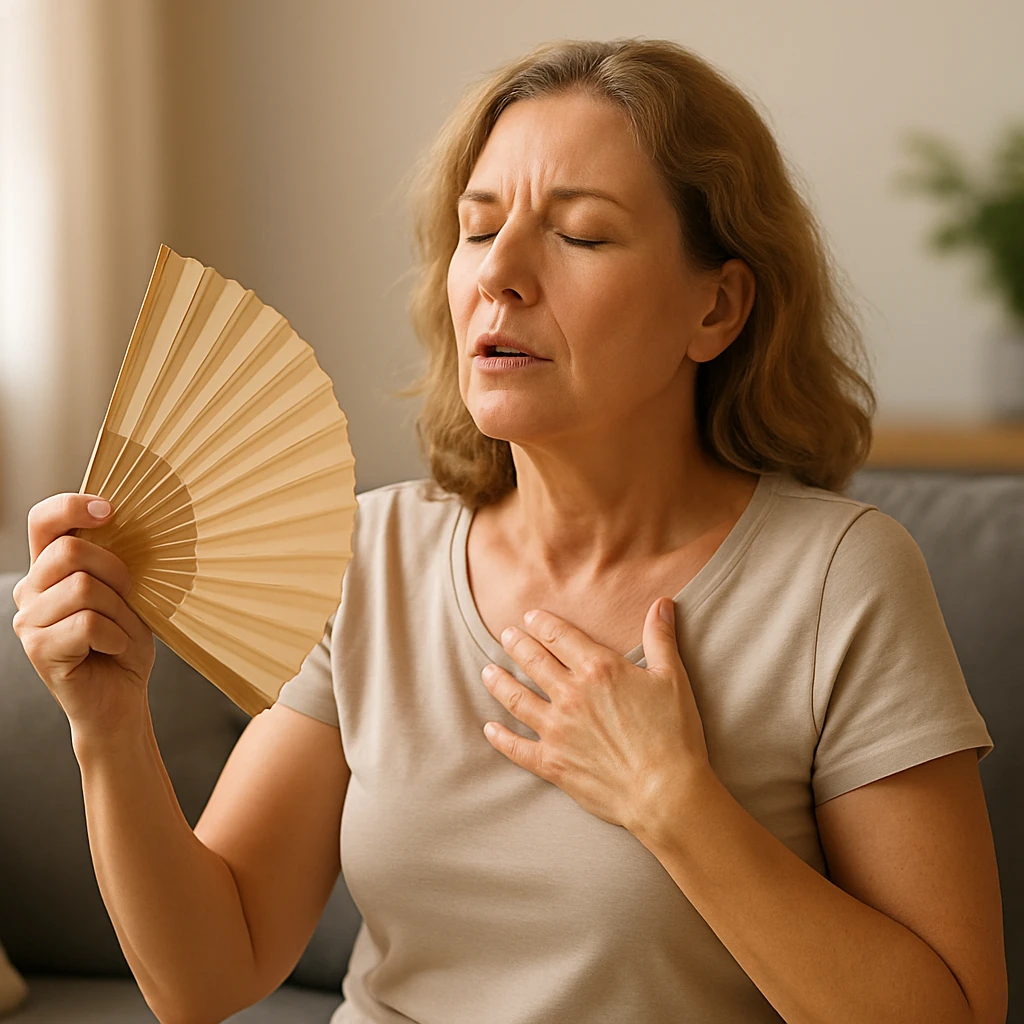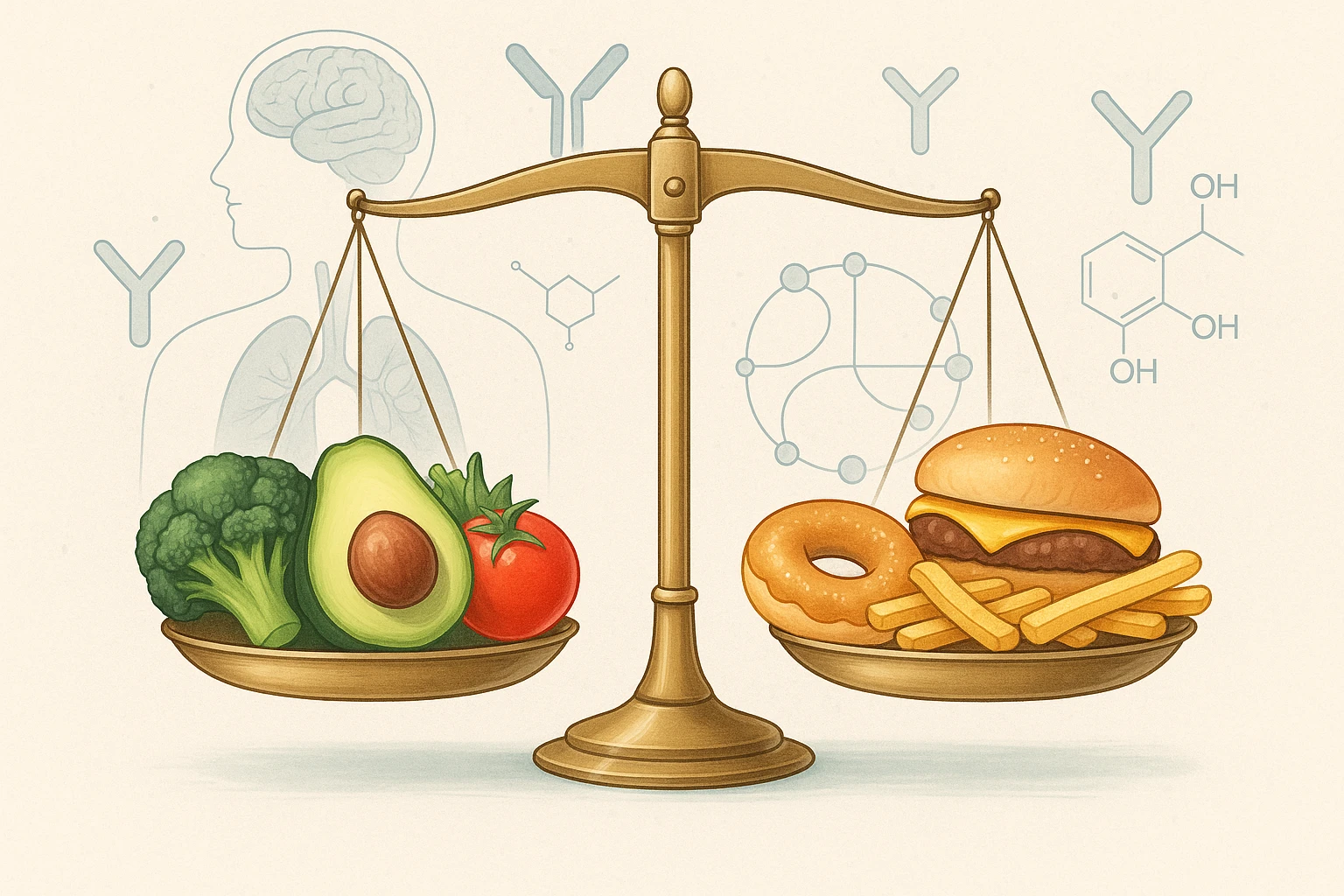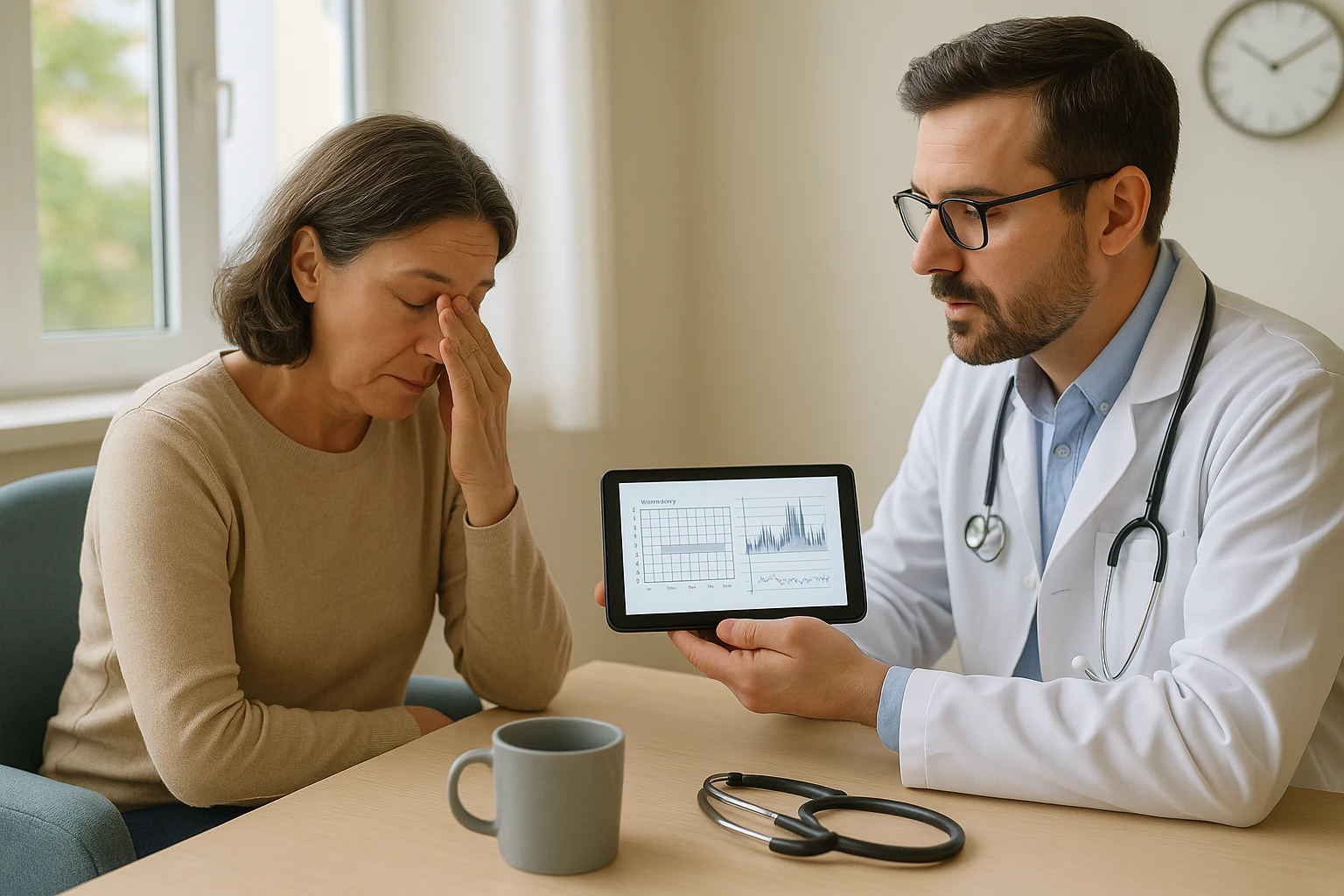Hot Flashes: Causes, Symptoms, and Treatment Options
Hot Flashes: Definition, Timing, and Prevalence
Hot flashes are among the most common symptoms during the transition to menopause. They are brief but often intense sensations of warmth that can spread through the upper body, sometimes accompanied by sweating and a flushed face. While they can be surprising or uncomfortable, hot flashes are a normal part of the body’s adjustment to changing hormone levels and usually improve with time.
What Hot Flashes Feel Like
Many people describe a hot flash as a sudden wave of heat that begins in the chest, neck, or face and quickly moves upward. The skin may redden or feel warm to the touch, and sweating can occur, especially on the upper body or scalp. Some individuals also notice a rapid heartbeat or mild lightheadedness. These episodes generally last about five to ten minutes and may leave a person feeling chilled afterward as the body cools down.
- Sudden heat spreading through the face, neck, or chest
- Flushed or reddened skin
- Increased sweating, often on the upper body or scalp
- Occasional rapid heartbeat or lightheadedness
- Brief chills as the episode ends
Hot flashes can occur during the day or at night. When they happen during sleep, they are often called night sweats and may cause awakenings or discomfort. Though brief, repeated interruptions to rest can affect energy and concentration during the day.
When Hot Flashes Occur
Hot flashes most often begin in the years leading up to menopause, known as perimenopause, when hormone levels fluctuate. They may continue for some time after the final menstrual period, known as postmenopause. The pattern and duration vary-some people experience them for only a few months, while others notice symptoms for several years. Although they can be bothersome, hot flashes are not harmful, and their frequency typically lessens over time as the body adapts to lower estrogen levels.

How Common They Are
Hot flashes are extremely common, affecting an estimated one-third to three-quarters of women during the menopausal transition. The likelihood of experiencing them depends on factors such as age, overall health, and individual sensitivity to hormonal changes. While nearly everyone entering menopause notices some change in temperature control, the intensity and impact of hot flashes vary widely from person to person. Recognizing this range can help normalize the experience and reassure those affected that they are not alone.
Why Hot Flashes Occur: Hormones and Temperature Regulation
Hot flashes arise because of changes in how the body regulates temperature during the menopausal transition. These changes are primarily linked to declining estrogen levels, which affect the brain’s ability to maintain a steady internal temperature. As hormone levels shift, the temperature control center in the brain becomes more sensitive to small variations in body heat, leading to the sudden warm sensations and flushing known as hot flashes.
Estrogen and Temperature Balance
Estrogen plays an important role in stabilizing the body’s thermoregulation system. In the brain, it helps maintain what is called the thermoneutral zone-a comfortable range where the body does not need to sweat or shiver to keep temperature steady. When estrogen levels drop, this zone narrows. Even a small rise in body temperature can trigger the body’s cooling response, such as increased blood flow to the skin and sweating. These rapid changes cause the characteristic heat surges that define a hot flash.
- Estrogen decline narrows the thermoneutral zone
- Small temperature increases trigger the body’s cooling mechanisms
- Reactions include flushing, sweating, and a brief sensation of heat followed by cooling
This process does not mean the body is overheating, but that its internal thermostat has become more reactive. Over time, as hormone fluctuations stabilize, the temperature control system often becomes less sensitive, and symptoms gradually lessen.
The Role of Nerve Pathways
In addition to hormonal effects, certain nerve pathways in the brain contribute to the onset of hot flashes. A group of neurons known as KNDy neurons-named for the chemicals they release: kisspeptin, neurokinin B, and dynorphin-help regulate both reproductive hormones and body temperature. When estrogen levels fall, these neurons become more active, sending stronger signals that narrow the thermoneutral zone and make the body more prone to temperature swings.

This heightened activity triggers the cascade of responses that produce a hot flash. Understanding these pathways has helped researchers identify new treatment targets aimed at calming the nerve activity responsible for these sensations. Although the experience can be uncomfortable, it reflects a temporary imbalance in the body’s adaptation to hormonal change.
Recognizing and Evaluating Hot Flashes
Recognizing how hot flashes present and when they may require medical evaluation can help individuals manage symptoms confidently. While the sensations are usually temporary and harmless, their frequency and intensity can vary greatly, sometimes affecting daily activities and sleep quality.
Common Symptoms and Patterns
Hot flashes are characterized by sudden waves of heat that often begin in the chest, neck, or face and quickly spread upward. The skin may flush or feel warm, and noticeable sweating can occur, especially on the scalp or upper body. Episodes usually last between five and ten minutes. Some people may also feel a rapid heartbeat or a brief chill as the body cools down afterward.
- Sudden warmth starting in the chest, neck, or face
- Flushed or reddened skin
- Increased sweating, often on the upper body or scalp
- Occasional rapid heartbeat or brief chill afterward
Hot flashes can appear sporadically or in clusters, and triggers such as stress, warm environments, or caffeine may make them more likely. Although they can be disruptive, these episodes reflect natural responses to hormonal changes around menopause rather than an underlying illness.
Night Sweats and Sleep Disruption
When hot flashes occur during sleep, they are commonly referred to as night sweats. These episodes can interrupt rest, leaving a person feeling tired or less alert during the day. Repeated awakenings from overheating can also affect mood and concentration, making it important to address persistent symptoms that interfere with quality of life.

How Hot Flashes Are Diagnosed
Doctors typically diagnose hot flashes based on a person’s description of symptoms and their stage of life. In most midlife women, the diagnosis is clinical-meaning it relies on reported experiences rather than laboratory tests. The pattern of vasomotor symptoms, such as sudden heat and sweating, together with the context of menopause, is usually sufficient to confirm the cause.
However, a clinician may rule out other possible causes if the presentation is atypical or occurs outside the expected age range. Conditions such as thyroid disorders or certain medications can cause similar sensations, so evaluation may include a brief physical examination and, when indicated, targeted blood tests to exclude these alternatives.
| Possible Cause | How It Differs |
|---|---|
| Menopausal transition | Occurs gradually with hormonal changes in midlife |
| Thyroid disorder | Often accompanied by weight or heart rate changes |
| Medication side effects | Linked to certain antidepressants or hormonal treatments |
When to See a Doctor
- Hot flashes are severe or interfere with sleep and daily life
- Symptoms occur unusually early or after menopause has ended
- Other concerning signs appear, such as unexplained weight changes or mood shifts
A clinician can help determine whether the symptoms are menopause-related and discuss options to relieve their impact on daily well-being.
Treatment Options for Hot Flashes: Hormonal and Nonhormonal Approaches
Managing hot flashes effectively depends on finding the right balance between relief and safety. The most proven treatment is hormone therapy, though several nonhormonal medications can also help. Because every individual’s health background and comfort level differ, treatment decisions are best made in partnership with a clinician who can tailor options to personal needs and medical history.
Hormone Therapy Explained
Hormone therapy, also known as menopausal hormone therapy, remains the most effective treatment for hot flashes and other vasomotor symptoms. It works by replacing the estrogen that declines during menopause, helping to stabilize the body’s temperature regulation. Women who still have a uterus usually take estrogen together with a progestogen to protect the uterine lining, while those who have had a hysterectomy may take estrogen alone.
- Estrogen helps restore balance to the body’s temperature control system
- Progestogen is added for women with a uterus to protect the uterine lining
- Therapy may include oral tablets, skin patches, gels, or other delivery forms
To minimize risks, hormone therapy is typically prescribed at the lowest effective dose and for the shortest duration needed to control symptoms. The treatment plan is individualized, considering age, time since menopause, symptom severity, and any personal or family health concerns. Many people find significant relief within a few weeks, though regular follow-up with a healthcare professional is recommended to ensure ongoing safety.
Nonhormonal Medication Options
For those who cannot or prefer not to take hormones, several nonhormonal medications can provide meaningful relief. Certain antidepressants, particularly SSRIs and SNRIs, have been shown to reduce both the frequency and intensity of hot flashes. These medications help regulate the brain chemicals involved in temperature control and are often started at lower doses than those used for mood disorders.
Another option is gabapentin, a medication originally developed for nerve pain and seizures. It can help decrease hot flash episodes, especially those occurring at night. While nonhormonal treatments may not eliminate symptoms completely, they can offer a moderate reduction in discomfort for individuals who cannot use estrogen safely.
| Treatment Type | Typical Use | Key Considerations |
|---|---|---|
| Hormone therapy (estrogen ± progestogen) | First-line for moderate to severe symptoms | Most effective; tailored to dose, duration, and health risks |
| SSRIs/SNRIs | Alternative for those avoiding hormones | Moderate relief; used at low doses |
| Gabapentin | Useful especially for nighttime symptoms | May cause drowsiness; taken at bedtime |
Balancing Benefits and Risks
Because treatment goals and health risks vary, choosing the best approach requires thoughtful discussion. Hormone therapy can provide powerful relief but may not be suitable for everyone. Factors such as cardiovascular risk, history of certain cancers, and clotting disorders need to be considered before starting therapy. Nonhormonal medications also have potential side effects, so weighing benefits against risks is essential for all options.
Shared decision-making between the patient and healthcare provider ensures that treatment aligns with safety and comfort. With careful monitoring and periodic review, most individuals can find an approach that effectively reduces symptoms and supports quality of life during the menopausal transition.

Living Comfortably with Hot Flashes: Lifestyle, Self-Care, and Long-Term Outlook
Hot flashes can be disruptive, but many people find that small daily adjustments and self-care routines make a meaningful difference. Even though lifestyle strategies alone may not completely stop symptoms, they can ease discomfort and help restore a sense of control. Over time, with consistent habits and reassurance, most people adapt and experience improvement.
Everyday Comfort Tips
Simple environmental and clothing choices can help manage body temperature swings:
- Wear light, breathable fabrics and dress in layers for quick adjustment when a hot flash begins.
- Keep a portable fan or cool water nearby for immediate relief.
- Avoid common triggers such as hot rooms, spicy foods, alcohol, or emotional stress.
- Maintain a comfortably cool environment, especially during sleep, to improve rest quality.
- Use bedding made of cotton or moisture-wicking material and keep the bedroom temperature low.
These strategies can be combined with medical treatment for a more complete management plan.
Stress and Sleep Care
Stress is a common trigger for hot flashes, and relaxation techniques can help regulate both mood and physical reactions. Practices such as slow breathing, yoga, or meditation promote calm and may lessen symptom intensity. Regular physical activity, when tolerated, supports overall well-being and helps with sleep regulation.
- Practice gentle breathing or mindfulness exercises during stressful moments.
- Follow a consistent bedtime routine to improve sleep quality.
- Avoid caffeine, alcohol, or heavy meals close to bedtime.
- Create a quiet, cool sleeping environment to minimize night sweats.
Outlook and Emotional Well-Being
Hot flashes often improve naturally over time, although the duration varies. For some, symptoms ease within a year or two, while others may experience them for several years after menopause. Knowing that this pattern is normal can be reassuring and help reduce anxiety about the experience.

Emotional support-whether from peers, family, or healthcare professionals-can play an important role in coping. Acknowledging the challenges of hot flashes while focusing on self-care and healthy routines can help maintain a positive outlook and quality of life during this transitional phase.
Frequently Asked Questions About Hot Flashes
- Are hot flashes a normal part of menopause?
- Yes. Hot flashes are one of the most common symptoms during menopause and result from natural changes in hormone levels, especially declining estrogen.
- How long do hot flashes usually last?
- Each episode typically lasts five to ten minutes, but the overall duration varies. Some people experience them for months, while others continue for several years after menopause.
- Do men ever experience hot flashes?
- Although most common in women, men can experience hot flashes if testosterone levels drop significantly, such as after certain medical treatments.
- Can hot flashes affect sleep?
- Yes. Night sweats, which are hot flashes during sleep, can cause repeated awakenings, leading to daytime fatigue and difficulty concentrating.
- What triggers make hot flashes worse?
- Common triggers include warm environments, spicy foods, alcohol, caffeine, and stress. Identifying and avoiding these can help reduce frequency.
- Are hot flashes dangerous to health?
- Hot flashes are not harmful, but they can affect comfort, sleep, and quality of life. Persistent or severe symptoms may warrant medical evaluation.
- What treatments work best for hot flashes?
- Hormone therapy is the most effective treatment for moderate to severe hot flashes. Nonhormonal options such as SSRIs, SNRIs, and gabapentin can also help.
- Can lifestyle changes reduce hot flash symptoms?
- Yes. Wearing breathable clothing, staying cool, managing stress, and maintaining good sleep habits can help ease discomfort and improve well-being.
- Why do hot flashes happen more at night?
- Body temperature naturally rises during sleep, and hormonal changes make the temperature control center more sensitive, triggering night sweats.
- Will hot flashes eventually go away?
- For most people, hot flashes gradually decrease as hormone levels stabilize after menopause, though timing varies from person to person.













